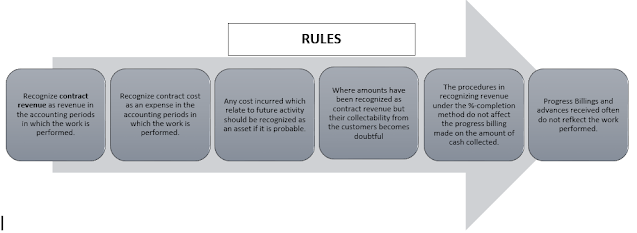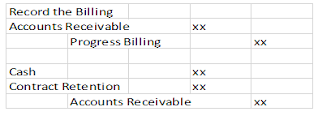LONG-TERM CONTRACTS (A QuickNotes)
A construction contract is a contract specifically negotiated for the
construction of an asset or a combination of assets that are closely
interrelated or interdependent in terms of their design technology, and
function, or ultimate use or purpose.
Types of Construction Contracts
1.
Fixed
price Contract
·
Agreed to a fixed price
·
Subject to cost escalation clauses
2.
Cost
Plus Contract
·
Reimbursed for allowed or otherwise defined
costs plus a % of these costs or a fixed fee.
Construction Revenue- the total amount of consideration receivable
under the contract.
Variation- instruction by the customers for a change in the scope
of the work to be performed under the contract.
Incentive Payment- additional amounts paid to the contractor are
specified to be met or exceeded.
Claims- an amount that the contractor seeks to collect from the
customers or another party as reimbursement for costs not included in the
contract price.
Construction Contracts
·
relate directly to the specific contract
·
Are attributable to contract activity in general
and can be allocated to the contract.
·
Chargeable to the customers
The cost that are direct:
1.
Site
labor costs
2.
Materials
used
3.
Depreciation
4.
Moving
PPE
5.
Hiring
PPE
6.
Design
and technical assistance
7.
Rectification
and guarantee work
8.
Claims
from third parties
A.
%-Completion
Method
·
An application of the accrual assumption
·
Avoids the mismatch between costs being
recognized as they are incurred and revenue only being recognized when the
contracts are completed.
I.
Input
Measures
·
Based on an established or assumed relationship
between a unit of input and productivity.
a.
Cost-to-cost
method- degree of completion is determined by comparing costs already
incurred with the most recent estimates of total costs expected to complete the
project.
b.
Effort-expended
Method- based on some measure of work performed.
II.
Output
measures- are measured in terms of results achieved. It was based on units
produced.
Financial Statement Presentation
Current Assets. Gross Amount due from Customers- It comprises the total cost incurred on the contract + cumulative recognized profit less
progress billings
Current Liability. Gross Amount due to Customers- Progress Billings
less total Cost incurred in the contract + cumulative recognized profit
Cost-Recovery Method
1. Recognize
Revenue only to the extent of contract costs incurred in which are expected to
be recoverable;
2. Recognize
contract costs as an expense in the period they are incurred.
Financial Statements Presentations
Current Assets- Total costs incurred on the contract, less progress
billings
Current Liability- Progress Billings less total cost incurred on
the contract
General Administrative Expense- change to income in the period when
they occur.
Contract Retention- guarantee the completion of the contract in satisfying
manner (Current Assets)




.png)


0 Comments